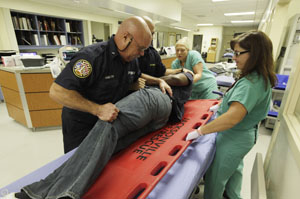

Level II Trauma CentersĪ level II trauma center also has 24-hour coverage by an in-hospital general/trauma surgeon as well as an anesthesiologist. These centers must participate in research and have at least 20 publications per year. The key physician liaisons to the trauma program (trauma surgeon, emergency medicine physician, neurosurgeon, orthopedic surgeon, critical care physician) must all do at least 16 hours of trauma-related CME per year. There must be > 1,200 trauma admissions per year. There must also be immediate availability of an orthopedic surgeon, neurosurgeon, radiologist, plastic surgeon, and oral/maxillofacial surgeon. If anesthesia residents or CRNAs are take in-hospital night call, an attending anesthesiologist must be available from home within 30 minutes.
#Trauma center levels california full
There must also be an anesthesiologist and full OR staff available in the hospital 24-hours a day as well as a critical care physician 24-hours a day. If a surgical resident is in the hospital 24-hours a day, then the attending surgeon can take call from outside the hospital but must be able to respond within 15 minutes. There must be a trauma/general surgeon in the hospital 24-hours a day. Level I Trauma CentersĪ level I trauma center provides the most comprehensive trauma care. This post will focus on levels I, II, and III trauma centers (non-pediatric).
#Trauma center levels california verification
The level of a trauma center is determined by the verification status of the hospital by the American College of Surgeons. The trauma center levels are determined by the kinds of trauma resources available at the hospital and the number of trauma patients admitted each year. In addition, there is a separate set of criteria for pediatric level I & II trauma centers. There are 5 levels of trauma centers: I, II, III, IV, and V. In total, in Columbus, we have two level I trauma centers, two level II centers, one level III center and one pediatric level I center. Across town, the larger tertiary care Ohio State University hospital is a level I trauma center. Our Trauma Centers are designated to serve an area from Banning and Beaumont to the West, Imperial County to the South, the Arizona border to the East, and Twentynine Palms and the high desert to the North.Our hospital recently became a level III trauma center. Trauma and surgical critical care surgeons are available 24 hours a day for your life-threatening emergency care needs at the Richards Emergency Trauma Center at Desert Regional Medical Center and at JFK Memorial Hospital. JFK Memorial is a Primary Stroke Center and Hi-Desert Medical Center is an Acute Stroke-Ready Hospital, both certified by The Joint Commission. Desert Regional Medical Center is, a DNV Certified Comprehensive Stroke Center. To prepare for such events, our emergency team follows proper protocol to assure heart and stroke patients receive potentially lifesaving treatment as quickly as possible. Heart attacks and strokes are frequent causes for emergency room visits. Plus, once your emergency care is complete, we can connect you with a primary care physician or specialists to help manage your ongoing care. Our emergency department’s highly trained physicians and triage nurses will treat your illnesses ranging from broken bones to life-threatening injuries. You can rely on Desert Care Network for full-service emergency care when you face life-threatening situations. A well-equipped ER prepared for injuries, heart care, stroke care and other life-threatening situations.Personalized care by physicians and nurses with advanced training in emergency medicine.



 0 kommentar(er)
0 kommentar(er)
